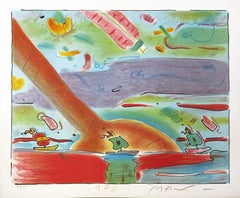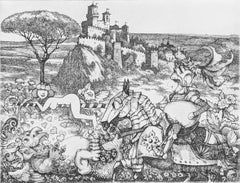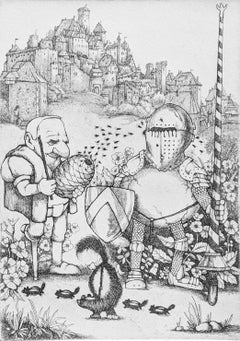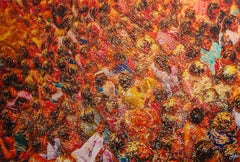Baby Landscape Prints
to
680
728
144
67
23
7
Overall Width
to
Overall Height
to
330
153
67
54
53
36
31
15
6
2
1
83
29
21
10
9
44
45
815
67
6
4
140
35
82
164
150
117
38
28
20
655
301
13
7,102
3,647
2,802
2,319
1,863
1,634
1,612
1,466
1,319
1,202
1,069
982
971
867
847
720
579
543
531
504
562
135
119
69
54
28
123
796
143
Art Subject: Baby
Nel Mare del Non Dormito Sonno, Surrealist Portfolio of Etchings by Bartolini
Located in Long Island City, NY
Artist: Anna Maria Bartolini, Italian (1934 - 2013)
Title: Nel Mare del Non Dormito Sonno
Year: 1986
Medium: Portfolio with 2 Etchings, signed and numbered and Poem by Mario Luzi, si...
Category
1980s Modern Animal Prints
Materials
Etching
SAILBOATS
By Peter Max
Located in Aventura, FL
Hand signed, dated and inscribed "PP Study" by the artist. Hand embellished by the artist. A unique variation. Artwork is in excellent condition. Certificate of Authenticity includ...
Category
1980s Pop Art Figurative Prints
Materials
Paper, Lithograph
$1,715 Sale Price
30% Off
CAMELOT
Located in Aventura, FL
Etching on paper. Hand signed, titled and numbered by the artist. Sheet size 10 x 14.75 inches. Image size 6 x 7.75 inches. Edition of 300. Artwork is in excellent condition. Cer...
Category
Late 20th Century Contemporary Landscape Prints
Materials
Paper, Etching
$200 Sale Price
50% Off
Moonscape II
Located in New York, NY
22"X30" silkscreen on Arches 88 paper; signed limited edition of 20.
This hand-pulled, silkscreen print depicts craters on the surface of the moon, with deep shadows and surface hi...
Category
2010s Contemporary Landscape Prints
Materials
Archival Paper, Screen
CAMELOT
Located in Aventura, FL
Etching on paper. Hand signed, titled and numbered by the artist. Sheet size 12 x 10 inches. Image size 7 x 4.75 inches. Edition of 300. Artwork is in excellent condition. Certi...
Category
Late 20th Century Contemporary Landscape Prints
Materials
Paper, Etching
$200 Sale Price
50% Off
French Contemporary Photo by Olivier Attar - Pastel d'HM
Located in Paris, IDF
Sold with wooden frame in black color or others : 90 x 130 x 5 cm - 35,4 x 51,2 x 1,9 in, ed. 1/7
Olivier Attar - Attoli is a French photographer born in 1971 who lives & works in L...
Category
2010s Contemporary Landscape Prints
Materials
Pigment, Canvas
Fred Deux - Grey Surrealism II - Signed Original Etching
By Fred Deux
Located in Collonge Bellerive, Geneve, CH
Fred Deux - Grey I - Signed Original Etching
Signed and Numbered
Edition of 100
Dimensions: 24 x 14 cm
Fred Deux
Fred Deux, illustrator, oral poet, writer, and, under the pseudonym Jean Douassot, author of a cult book, La Gana, was a singular artist who cannot be categorised in terms of art fashions and trends. This autodidact, born in the basement of a large house in Boulogne-Billancourt to a working-class family, constantly had to overcome, as he would say. “He had to overcome”: overcome the basement walls to access the life which called him and burnt inside him. Overcome the barriers between the arts, moving from drawing to the written word, and from the page to the tape recorder, in the face of which he recounted stories to himself in a sort of endless reverie, constantly exploring the unknown in him. Overcoming and being overcome: gradually immersing himself in drawing, so that it was life itself which overcame him and surrendered to him.
Timeline
1924
Born in Boulogne-Billancourt, Paris. The Deux family lived in the basement of a building close to the Seine that was often flooded. These living conditions formed the biographical core around in which the artist would develop his work as a future writer and artist.
1942
Deux worked in a factory as an electrician and night guard.
1943
Deux becomes part of the FTP group to resist against the factory. And then joined the Maquis du Doubs.
1945
At the liberation, Deux joined the Moroccan Goumier, and took part of the campaigns of Vosges, Alsace and Germany.
1947
Returned to France. Installation in Marseille. Worked in an important library that belonged to the family of his wife.
1948
Discovered Breton, Bataille, Cendrars, Peret, Sade... and founded the sub-group of Surrealists in Marseille and formed a link with the literary magazine of Marseille, Cahiers du Sud
Encounters the works of Paul Klee.
He begins creating his first stains with paint for bicycle and impressions (fabric and ink). At the same time, he begins to take notes for what would become "Les Rats", first version of "La Gana".
1951
Meets Cecile Reims...
Category
1970s Surrealist Still-life Prints
Materials
Etching
The Jolly Flat Boat Men
By George Caleb Bingham
Located in Missouri, MO
The Jolly Flat Boat Men, 1847
After George Caleb Bingham (American, 1811-1879)
Engraved by Thomas Doney (French, active New York 1844-1849)
Engraving with Hand-Coloring
Published by The American Art-Union, New York (1838-1851)
Printed by Powell and Co.
18 x 24 inches
32 x 38 inches with frame
In 1847, the American Art-Union purchased Bingham’s painting "The Jolly Flat Boat Men" (1846; National Gallery of Art) directly from the artist. The subscription-based organization, founded in 1838 as the Apollo Association, boasted nearly ten-thousand members at this date. For an annual fee of five dollars, each received a large reproductive engraving and was entered in a lottery to win original artworks exhibited at the Art-Union’s Free Gallery. Aimed at educating the public about contemporary American art, the organization developed an impressive distribution network that reached members in every state. The broad circulation of the Art-Union's print helped to establish Bingham's reputation and made his river scene famous.
Born in Augusta County, Virginia in the Shenandoah River Valley, George Caleb Bingham became known for classically rendered western genre, especially Missouri and Mississippi River scenes of boatmen bringing cargo to the American West and politicians seeking to influence frontier life. One of his most famous river genre paintings was The Jolly Flatboatmen completed in several versions in 1846. This first version of this painting is in the Manoogian Collection at the National Gallery of Art. Fame resulted for this work when it was exhibited in New York at the American Art Union whose organizers made an engraving of 10,000 copies and distributed it to all of their members. Paintings such as Country Politician (1849) and County Election (1852) and Stump Speaking (1854) reflected Bingham's political interests.
In 1819, as an eight-year old, he moved to Boon's Lick, Missouri with his parents and grandfather who had been farmers and inn keepers in the Shenandoah Valley near Rockingham, Virginia. Reportedly as a child there, he took every opportunity to escape supervision to travel the River and watch the marine activity.
His father died in 1827, when his son was sixteen years old. His mother had encouraged his art talent, but art lessons were not easily obtainable. In order to earn money, he apprenticed to a cabinet maker but determined to become an artist. By 1835, he had a modest reputation as a frontier painter and successfully charged twenty dollars per portrait in St. Louis. "His portraits had become standard decorations in prosperous Missouri homes." (Samuels 46). In 1836, he moved to Natchez, Mississippi and there had the same kind of career, only was able to charge forty dollars per portrait.
He remained largely self taught until 1837, when he, age 26 and using the proceeds from his portraiture, studied several months at the Pennsylvania Academy of the Fine Arts. He later said that he learned much of his atmospheric style and classically balanced composition by copying paintings in collections in St. Louis and Philadelphia and that among his most admired painters were Thomas Cole, John Vanderlyn, and William Sidney Mount. Between 1856 and 1859, Bingham traveled back and forth to Dusseldorf, Germany, where he studied the work of genre painters. Some critics think these influences were negative on his work because during that time period, he abandoned his luminist style that had brought him so much public affirmation.
Bingham credited Chester Harding (1792-1866) as being the earliest and one of the most lasting influences on his work. Harding,a leading portraitists when Bingham was a young man, had a studio in Franklin, near Bingham's home town. In 1822, when Bingham was ten years old, he watched Harding finish a portrait of Daniel Boone. Bingham recalled that watching Harding with the Boone portrait was a lasting inspiration and that it was the first time he had ever seen a painting in progress. Harding suggested to Bingham that he begin doing portraiture by finding subjects in the river men, which, of course, opened the subject matter that established fame and financial success for Bingham. Harding also encouraged Bingham to copy with paint engravings. He later painted two portraits of Boone but, contrary to the assertions of some scholars, he did not do Boone portraits in the company of Harding.
Bingham's portraits of Boone are not located, but one of them, a wood signboard for a hotel in Boonville circa 1828 to 1830, showed a likeness of Boone in buckskin dress...
Category
1840s Hudson River School Figurative Prints
Materials
Engraving
Price Upon Request
Flowers, FS II.67
By Andy Warhol
Located in Miami, FL
Technical Information:
Andy Warhol
Flowers, FS II.67
1970
Screenprint
36 x 36 in.
Edition of 250
Signed and stamped number on verso
Category
1970s Pop Art Still-life Prints
Materials
Screen
Price Upon Request
Whistle
By Valton Tyler
Located in Dallas, TX
In The New York Times Arts in America column, Edward M. Gomez writes of Valton Tyler, "visionary seems the right word for describing his vivid, unusual and technically refined painti...
Category
1970s Surrealist Still-life Prints
Materials
Rag Paper, Etching
Price Upon Request
Rear Section of B
By Valton Tyler
Located in Dallas, TX
In The New York Times Arts in America column, Edward M. Gomez writes of Valton Tyler, "visionary seems the right word for describing his vivid, unusual and technically refined painti...
Category
Late 20th Century Surrealist Prints and Multiples
Materials
Etching, Aquatint
Price Upon Request





